
When I was young, just like many other children, I was obsessed with dinosaurs… but there were other creatures that seemed more real to me, probably because they were still around… and also living in the same house. Other children kept guinea pigs and hamsters, but my preference was for the cold blooded killers — mostly reptiles and amphibians, and then there were the spiders… I really liked spiders. A friendly neighbour told my mother that it was a phase I was going through and I’d get over it… but I never did.
Beyond all the beastliness indoors, there was the garden where the extraordinary appearance and behaviour of one group of insects in particular grabbed my attention, and although I didn’t know it at the time, little changed from those to be found in the early fossil record. These wonderful creatures were dragonflies — the Odonata, an order of insects that predate dinosaurs by around 70 million years. Isn’t that something?… And it’s almost true.

Homo sapiens have been around for perhaps 30,000 years. It isn’t comparable anymore than it’s a competition, but a palaeontologist will tell you that to claim dragonflies have been around for 300 million years is pushing things a bit, because the ‘dragonflies’ of the distant past appear less developed than the ones we see today, and how closely related they are is open to question. In consequence they have been classified into a separate order: the Meganisoptera, formerly known as the Protodonata. Pro meaning prior (Pro-Odonata) and this makes sense, because no representatives of this order have survived to the present day — they have been seen off by chance and evolution and long ago superseded.

When I sketched the above image from a fossil, it was obvious that this creature had eyes smaller than those of modern dragonflies where they take up most of the head. There are also differences in the structure of the wings, but making comparisons from a fossil embedded in a rock that is millions of years old isn’t easy, and probably best left to the taxonomists.
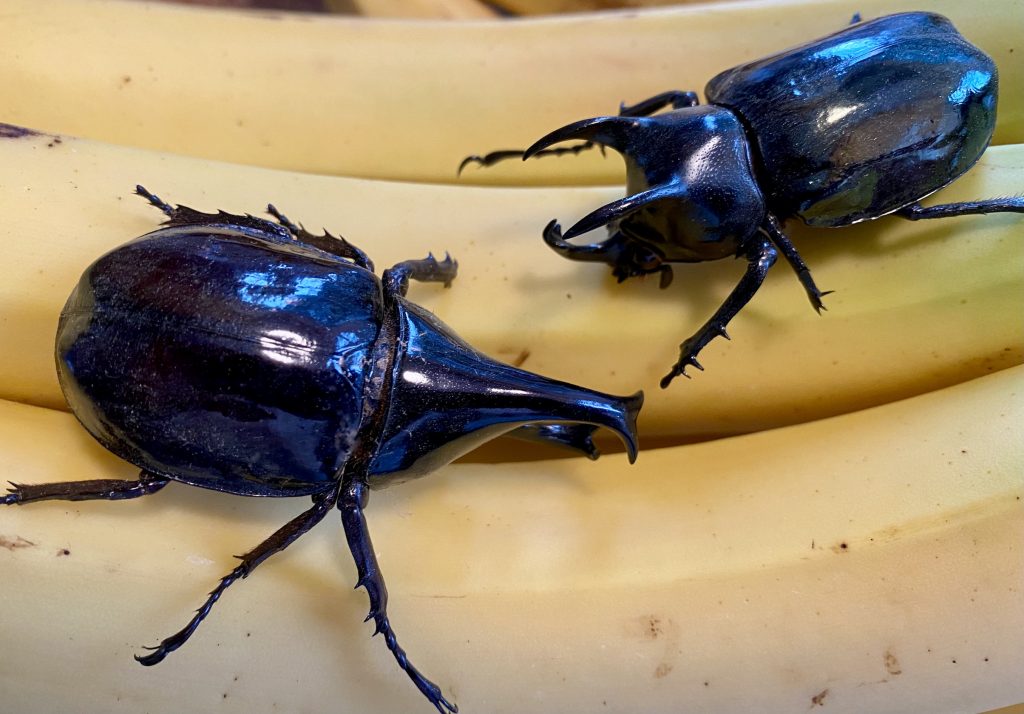
The answer is that rhinoceros beetles evolved horns to enable males to achieve dominance over other males, giving them a better chance of mating with attendant females — in evolutionary terms this is sexual selection. Interestingly, the development of horns on these beetles has been ebbing and flowing for millions of years.
Beetles began their evolutionary journey around the same time as dragonflies, but meandered a very different path to the future. Trychogomphus beetles, despite their tough tank-like appearance are herbivores, whereas dragonflies are fierce predators and during the Jurassic Period were the top predators of their time, although back then, they had not been honed by predation to the complexity we see today. Pterosaurs were the first vertebrates to take flight in the late Jurassic; the dentition of some smaller species indicate that they fed on insects, and dragonflies would certainly have been on their menu.
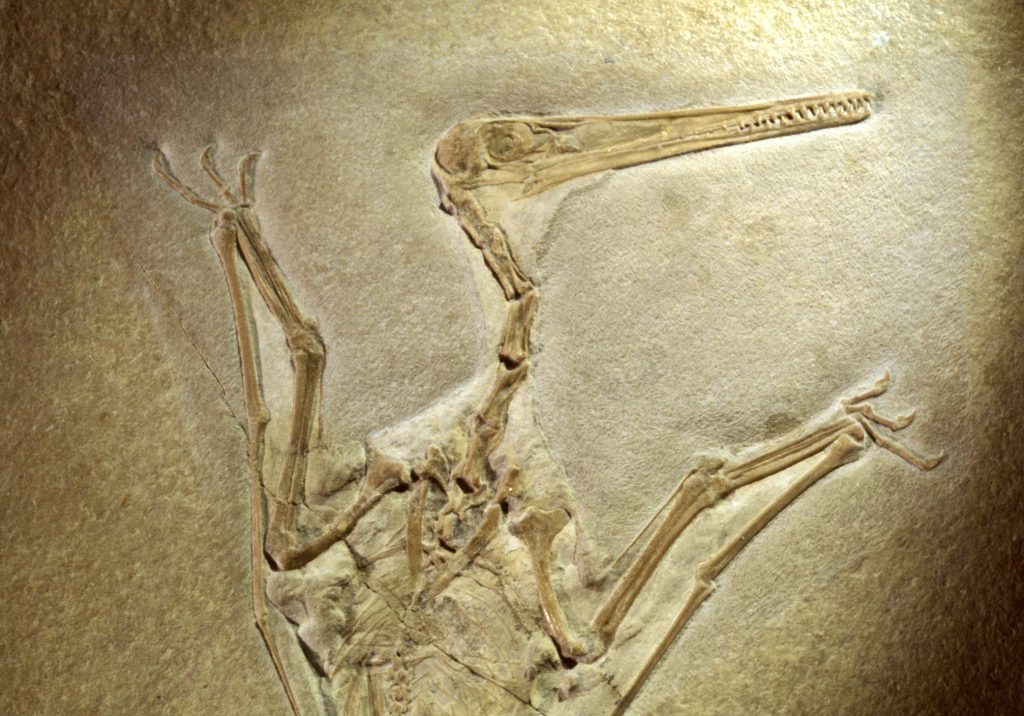
Later, in the Lower Cretaceous a branch of theropod dinosaur took to the air as birds, and were soon competing with the pterosaurs for food, although by this time many of the pterosaurs had evolved into far larger forms and taken up fishing.

Imagine a world before birds evolved — there would have been no birdsong and the most impressive creatures of the air would have been dragonflies; but when birds joined the foodfest they would have put pressure on ‘early dragonflies’ to adapt or disappear.
Suddenly, dragonflies were no longer the apex predator of the time, they were now being preyed upon, and the evolutionary arms race to follow would put them on the road to the complexity we see today.
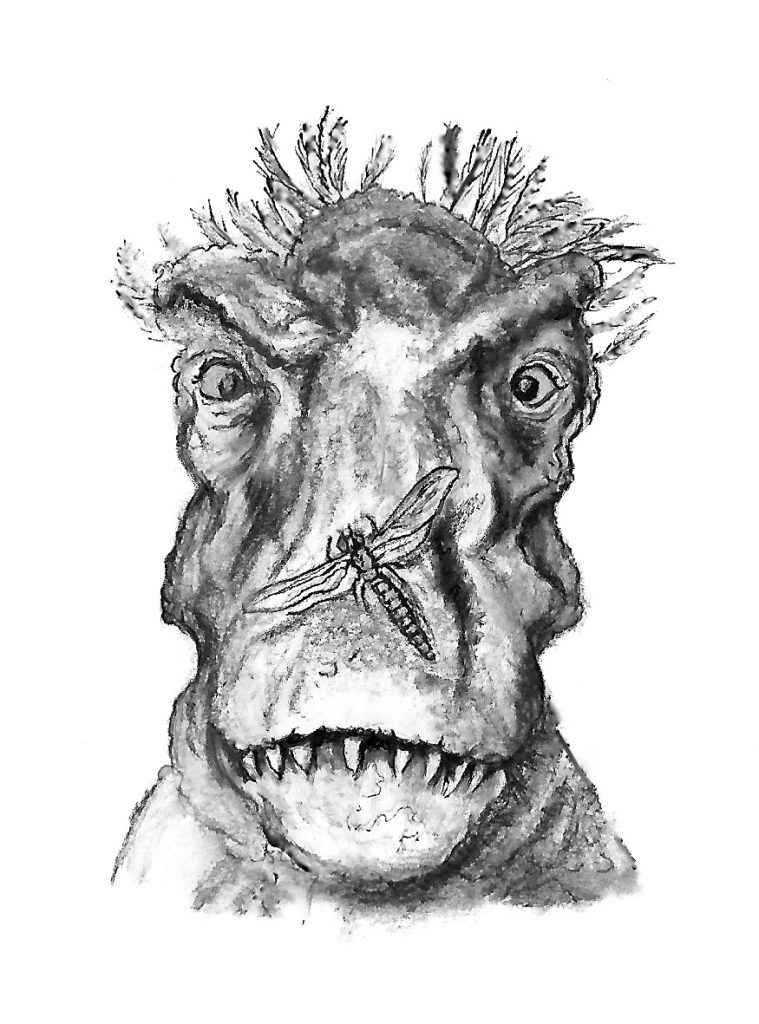
As some dinosaurs evolved to greater size, I imagine dragonflies perching upon them in much the same way they do today on crocodiles and photographers. I won’t make further comparisons — T. rex would have been hopeless at photography, what with those tiny little arms and a couple of spindly fingers at their ends.
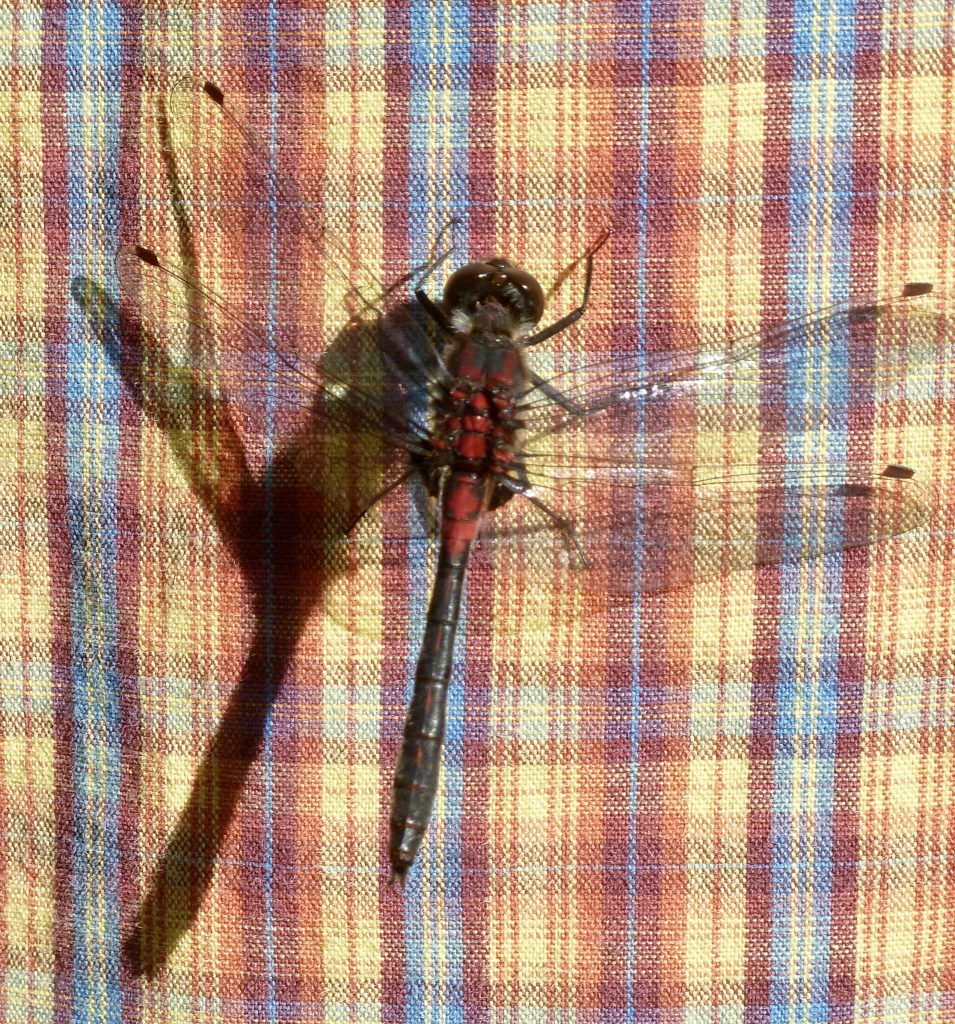
Only recently has the evolutionary history of dragonflies been more fully understood. It is now accepted that dragonflies ‘proper’ made their appearance around 200 million years ago. Throughout their development there have been pronounced differences between taxonomic groups and this has taken some unravelling.
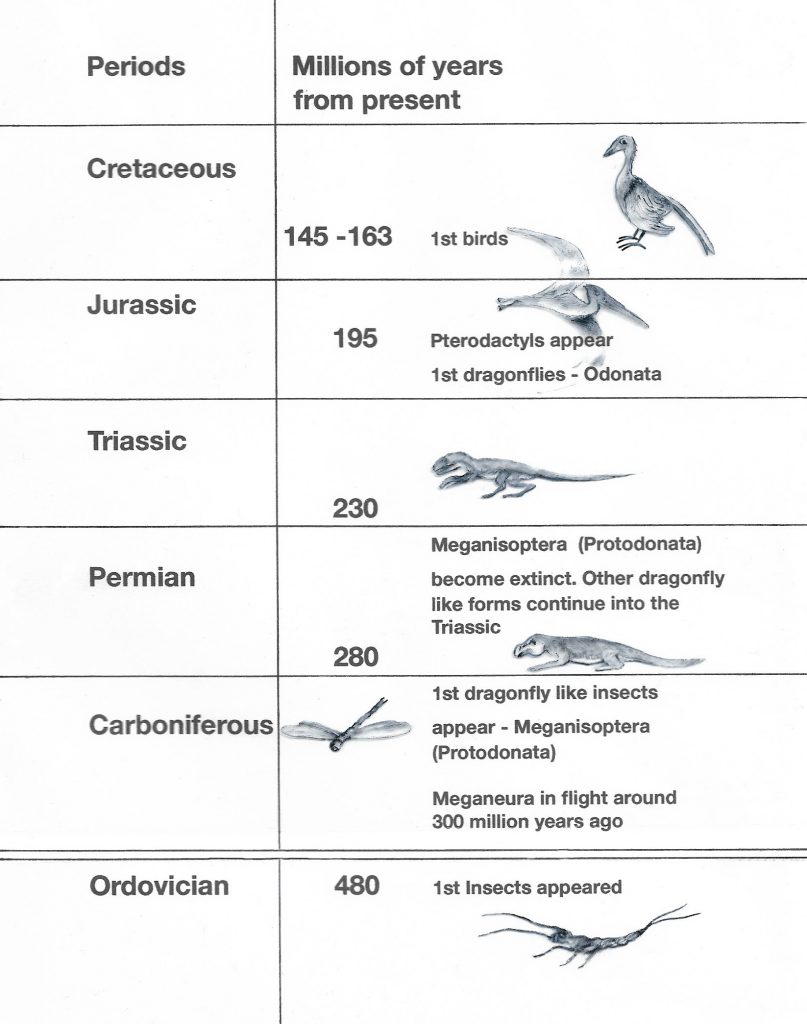
It might seem extreme to concern ourselves with evolutionary change in the distant past, but it is important — there is much to be gained by understanding how things change. If we could time-travel back to see members of the long extinct Meganisoptera, most of us would say, ‘Those are dragonflyies’ and it is only with the precision common to scientists that this would be a hanging offence. Most of us have more pressing issues to consider, nevertheless, the past is the foundation of the future and we ignore it at our peril. If the evolution of dragonflies tells us anything, it is that nothing stays the same forever; although most of us are content to leave the detail to experts… and then get annoyed with their irritating precision when our preference is for broad generalisations — but getting small things right is the foundation for sorting out many of the bigger issues we all must face.


How easy it is to identify a specimen depends on the availability of evidence and this traditionally comes from the geological record.
Today there are many other ways to glean information — there may be chemical remnants that can sometimes provide extra information; and in recent time cladistics — the science of judging relatedness by comparing shared characteristics amongst different species has become increasingly important; add to this DNA evidence that can links species still around and half a dozen another techniques that include computer modelling, and it is clear, things are better now than they were for Victorian naturalists who relied entirely on the fossil record.
Fossil evidence can be very thin. Imagine, on a Thursday afternoon two hundred million years ago, it rained heavily and a flood swept large numbers of animals away, covered them in sediment, and preserved some as fossils. Much latter a palaeontologist stumbles across them and begins to make value judgements about the past. Such happy accidents of mass preservation (as with the previously mentioned Solnhofen limestone beds) are unusual. Add further geological upheavals and erosion, and it is no wonder there are huge gaps in the geological record. Everything we know about the plants and animals of the past has been hard won, and the importance of this all should not be underestimated.
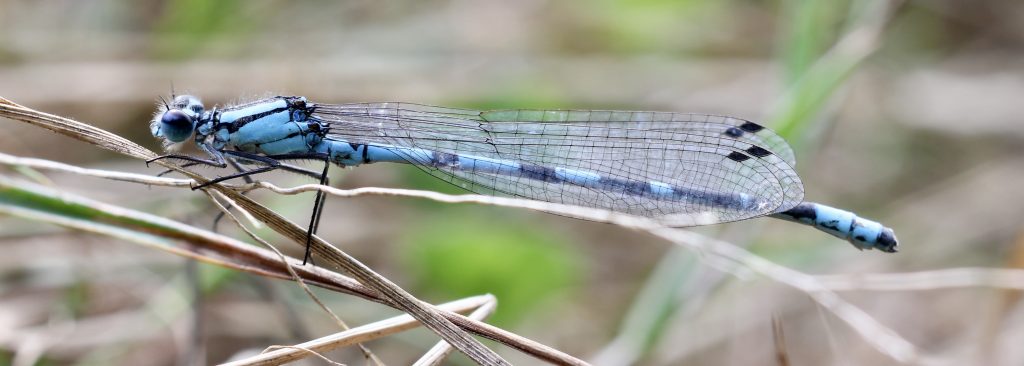

Some people think the next great human endeavour will be to visit Mars — a strange priority when our own planet is facing a potential mass extinction. It is as if when we get through wrecking the complex systems that presently support us, we can just get on a spaceship and move to another planet, when the priority should be to conserve the diversity of life on Earth — there is plenty of talk about this but very little action, and no shortage of wealthy old men prioritising their dreams to touch the edge of space.
Mars will be a disappointment: nothing as remotely interesting as a dragonfly will be discovered, and there won’t be any rhinoceros beetles. There is nothing quite so alien as the strange life forms to be found on Earth, which sounds ridiculous, but the most terrifying creatures are usually small and we barely notice them. If a colourful predatory insect was discovered on the Red Planet, it would make headlines on the Blue Planet in exactly the same way that a dragonfly showing up in your garden would not.

Out in the garden there are probably more natural wonders to be found than anywhere else in our solar system. Other planets are interesting, but biologically it is Earth that has hit the jack-pot. Without doubt, we should be exploring space, but with our present limitations, should be doing so with robots. allowing us to spend the big money on preserving the natural biodiversity of our planet. Sadly, our minds are programmed to appreciate novelty — a trip to another world would certainly provide the ultimate social media selfie… and what could be more important than that? Tiring of the familiar, we hardly notice the small creatures in passing as we wander down the garden path… we think we know them, but really we do not.
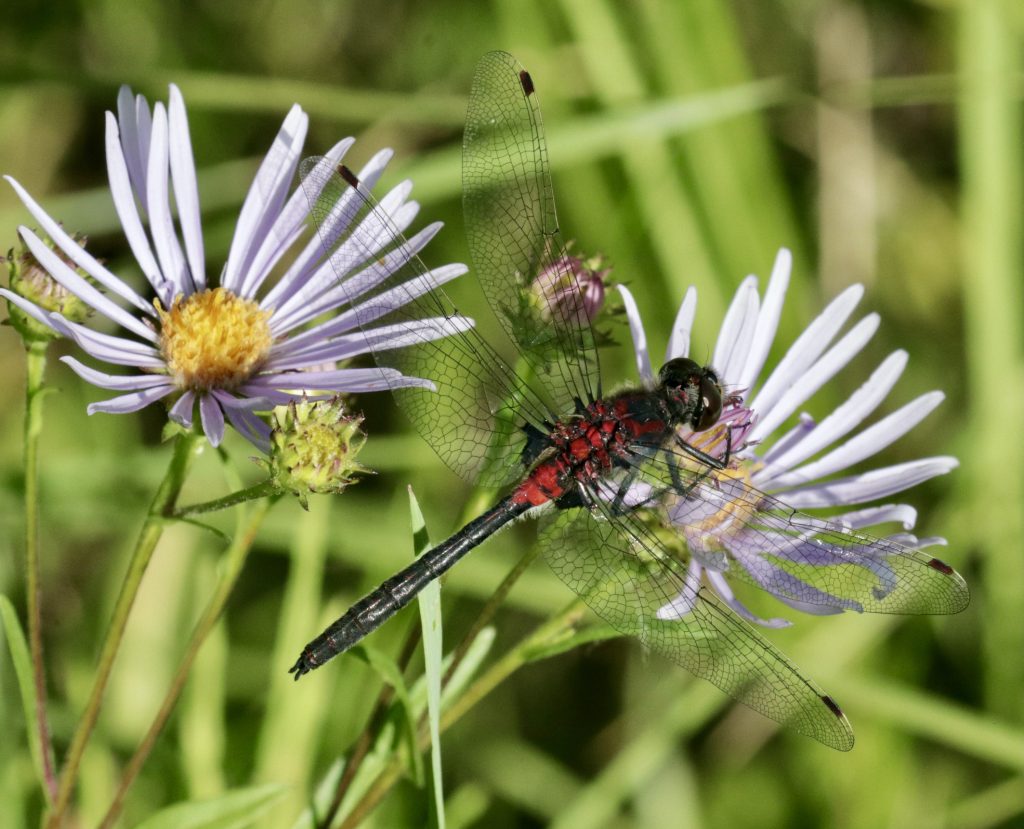
When I see a dragonfly I can hardly believe my luck – it is as if I am still 7 years old. Those around me are moving on and I’m thinking, “Wow… That’s incredible!” Then I take a photograph, which always leads to more questions than answers — looking at the natural world in detail always increases our awareness of how little we know.
For example, the general complexity to dragonfly wings is noticeable — look carefully and it is not too difficult to appreciate that the incredibly ornate vein patterns exist for entirely practical reasons.
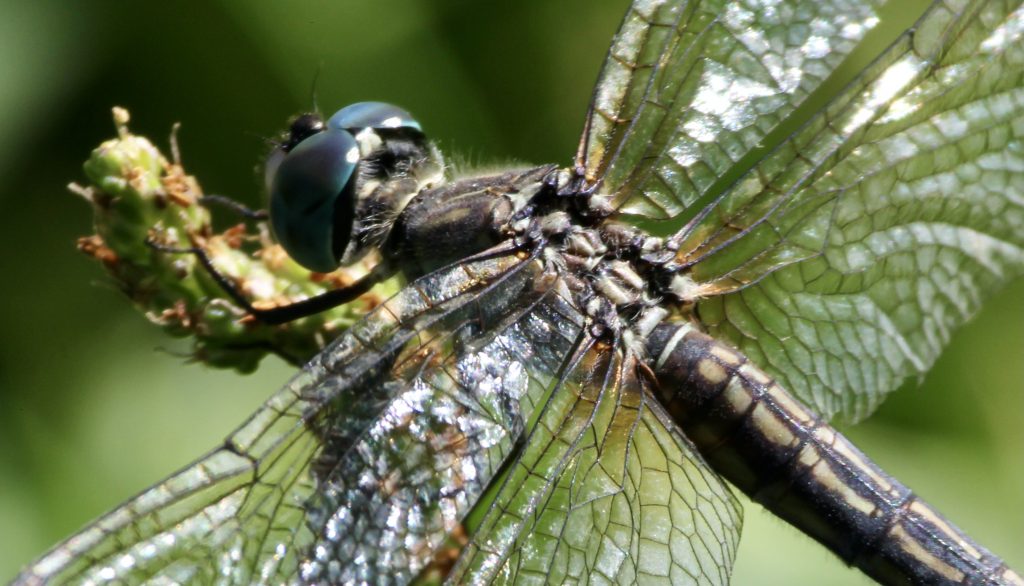

Consider those marks on the leading edge of the front wings of dragonflies. Darker, and usually coloured in appearance they are the pterostigma — a thickening that improves efficiency when a dragonfly is gliding. Similar species that were around when dinosaurs roamed the Earth didn’t have them; and that’s a big deal — the thickening would have provided a distinct advantage to forms that developed them, outcompeting others that did not. Once you know this, it is difficult not to notice other things about dragonflies that need explaining.

The leading edge of a cardinal meadow hawk’s wing — pictured below — shows a clear pattern of venation and it’s difficult not to wonder why. Look closely and it is obvious that the dragonfly wing is corrugated to increase rigidity, but that’s only part of a bigger story, and there’s still a lot we don’t know about the hows and the whys of such complexity.
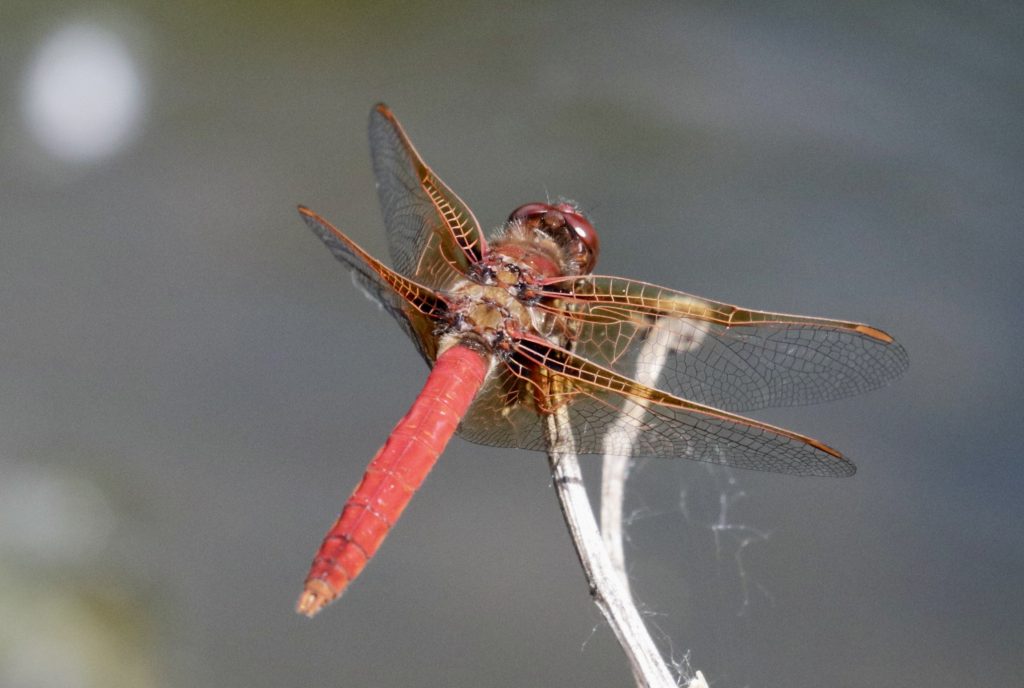

When such puzzles are answered, we may incorporate the information into structures that we build for ourselves. Aerodynamic flight is about gaining optimal strength without over-engineering structures that need to be light. But there is a lot more to consider — flexing for example. A dragonfly wing looks rigid when the insect is perched waiting for a meal to go by, but when flying, the wings need to flex to increase stability. From our perspective the developmental work has been done and our thoughts can take flight by simply observing — dragonfly wings have been millions of years in the making and are tried and tested blueprints for our own endeavours. Currently a new generation of agile tiny drones with insect like wings are in development with dragonflies the basic plan.
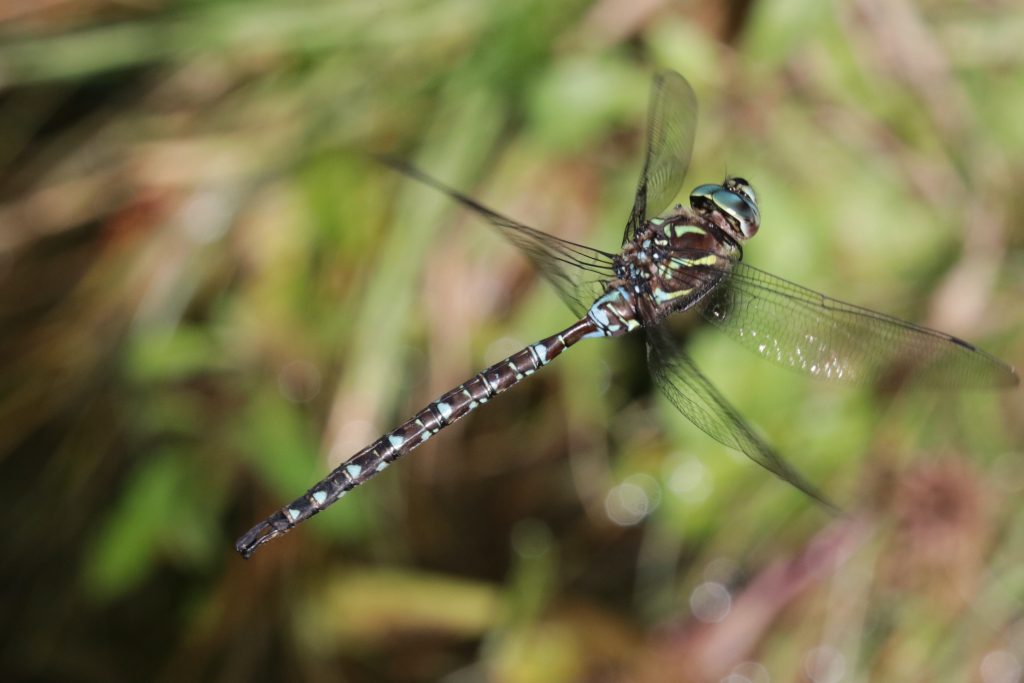
Photography reveals that when in flight dragonfly wings do not simply move up and down in relation to their bodies — the movement more closely follows a figure of eight. It is much the same with hummingbirds where this motion has evolved independently, and allows both insect and bird to be more maneuverable.
When the adult form emerges from its larval encasement it takes a few hours for the body and wings to pump up — during the drying and hardening of the outer body parts the creature is unable to fly and remains vulnerable. If things get really bad and it rains hard, the impact can prove entirely disabling. Yet the process of becoming an extraordinary maneuverable air ace with millions of air miles on the clock has worked well for the Odonata — they have managed to exist for a very long time without major changes in form, perhaps because evolution operates on the simple maxim: if it an’t broke, don’t fix it!
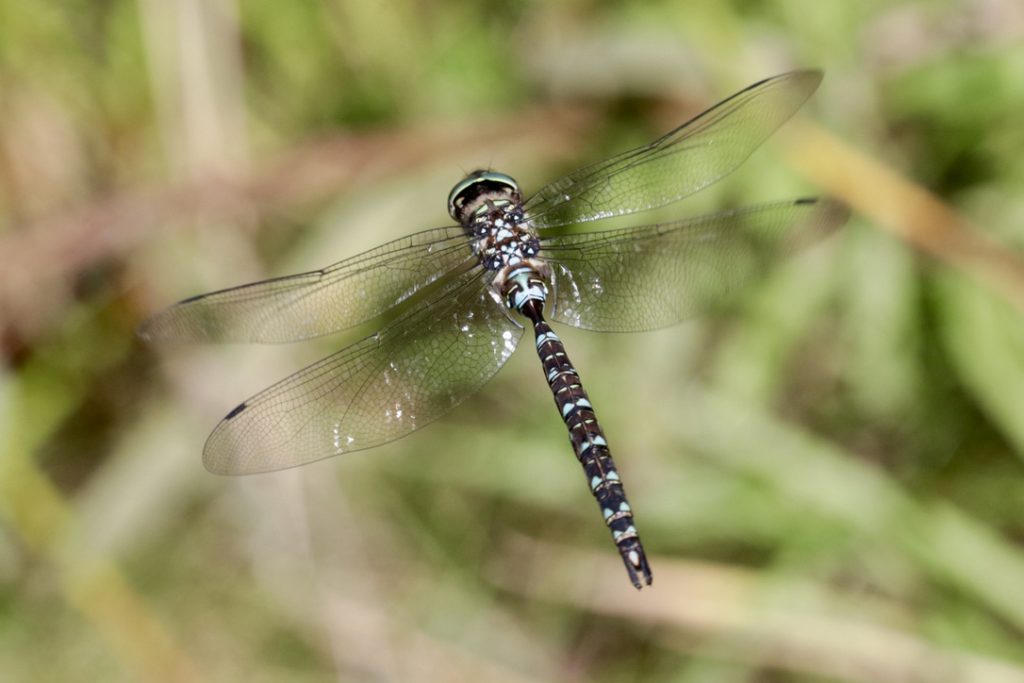
There was at times during the Carboniferous Period when atmospheric Oxygen levels were twice what they are today because there were a greater numbers of plants photosynthesizing. If we were able to travel back to this earlier time, we’d be in trouble, because despite Oxygen’s essential role in life on Earth, at high concentrations it is poisonous to a great many life forms. Nevertheless, dragonflies were able to grow bigger (as was the case for Meganeura mentioned previously), but there are limits as how big an animal with an externally supportive skeleton can get — it is the case for all insect; they have air tubes carrying oxygen to body parts rather than the more efficient lungs that help drive mammalian activity. Dragonflies have soft abdomens which allows them to pump a little air, but size is always limited by structure. There is a theory that in order to cope with higher Oxygen levels dragonflies of the period would have developed narrower breathing tubes and increased body size.
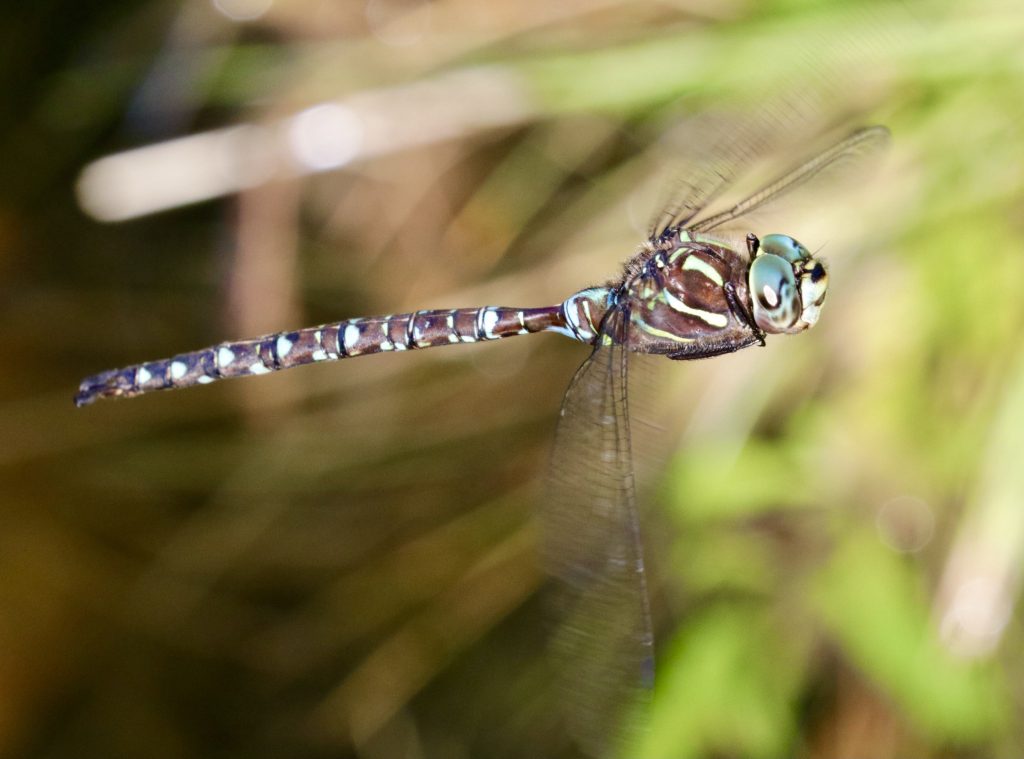
Some scientists have questioned whether this is accurate, but laboratory experiment with developing dragonfly larvae still around today has demonstrated that this is exactly what happens, although not to the same degree as it did for Carboniferous species. The general rule seems to be — supply more oxygen and the ‘breathing “tubes become narrower and the body size increases; give the larvae less oxygen and the ‘breathing’ tubes become wider and the insects that emerge are smaller, which suggests the Oxygen theory isn’t pie in the sky ridiculous.
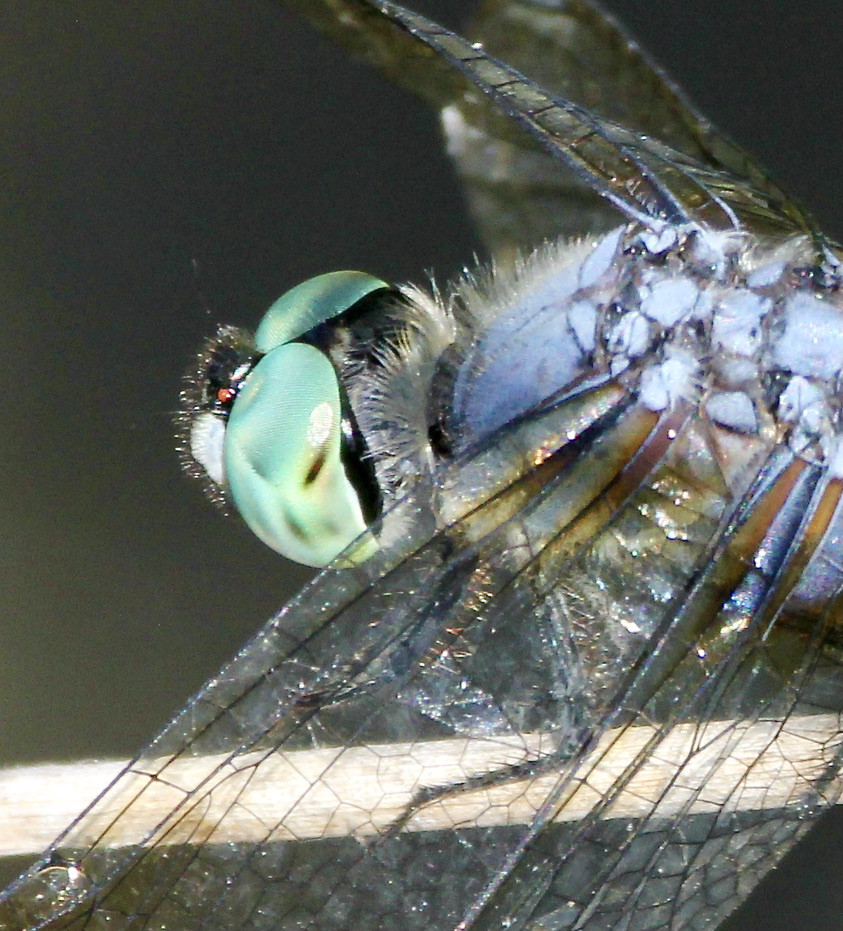
And what about those eyes? Dragonflies and bees have the largest eyes in the insect world with about 30,000 facets in each compound eye. We have a reasonable idea of how much information this kind of eye provides, but how the brain interprets input is open to question, although by observing how insects react it is clear that almost any stimulus elicits and an immediate reaction, and is to be expected with any efficient predator.
For most of their lives dragonflies are not dragonflies at all — they are underwater larval forms that breathe through gills and although small, might best be described as monstrous. If today they grew to the size of similar species during the Carboniferous, we might think twice about going into the water where they lived.

The larval forms of dragonflies (nymhs) spend from one to several years underwater, living as fierce submersible predators shedding exoskeletons as they grow, until one day they are ready to emerge from the water. Once into what we consider ‘our world’, they climb upwards, then grasp whatever they have climbed to emerge from their capsule.
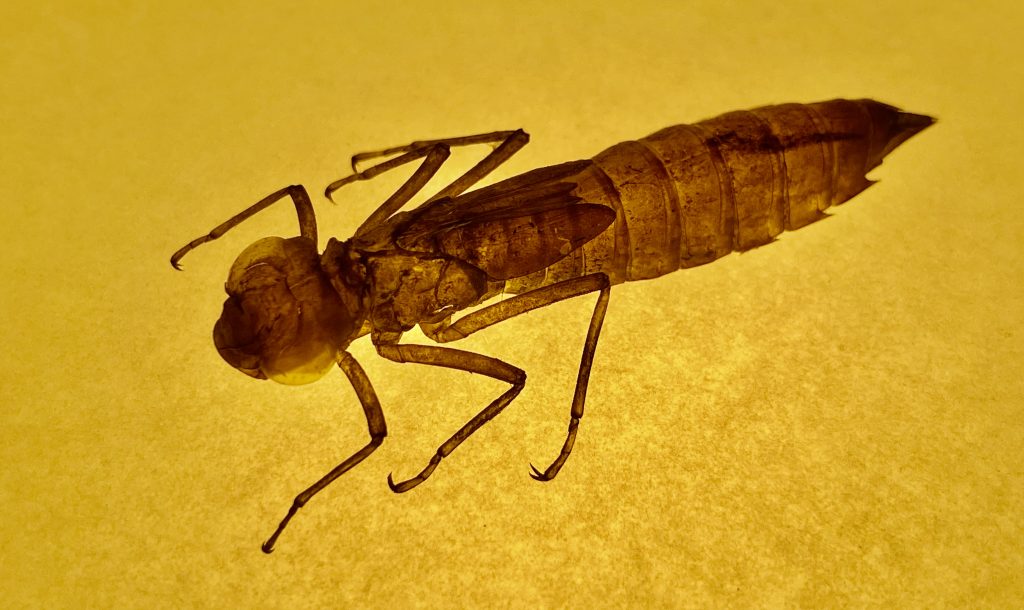
One day they are deadly aquatic assassins, the next, fierce aerial predators driven now by the priority to reproduce. Most dragonflies have shorter lives above than they do under water, and although some take time away from the ponds lakes and rivers to feed, at the top of their ‘to do list’ is mate and lay eggs successfully before they die. On more than one occasion when taking pictures, I have lost my subject to a hungry bird — over millions of years nothing about this appears to have changed; but this is an illusion, as both birds and dragonflies are continually improving their chances by the process of natural selection in what has become a rather one sided flight to the death.
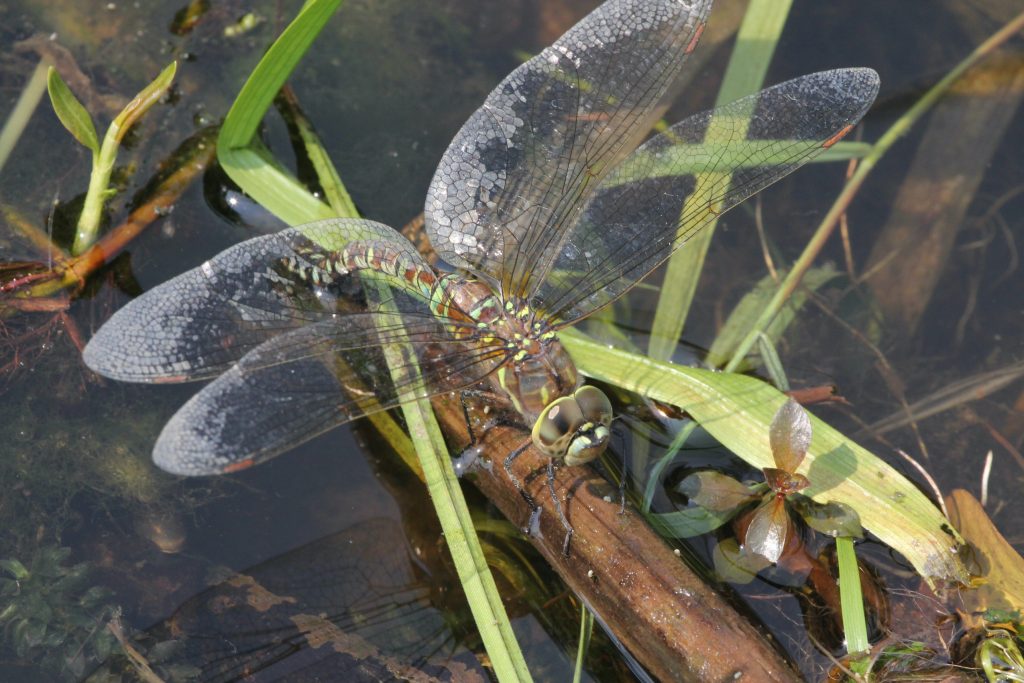
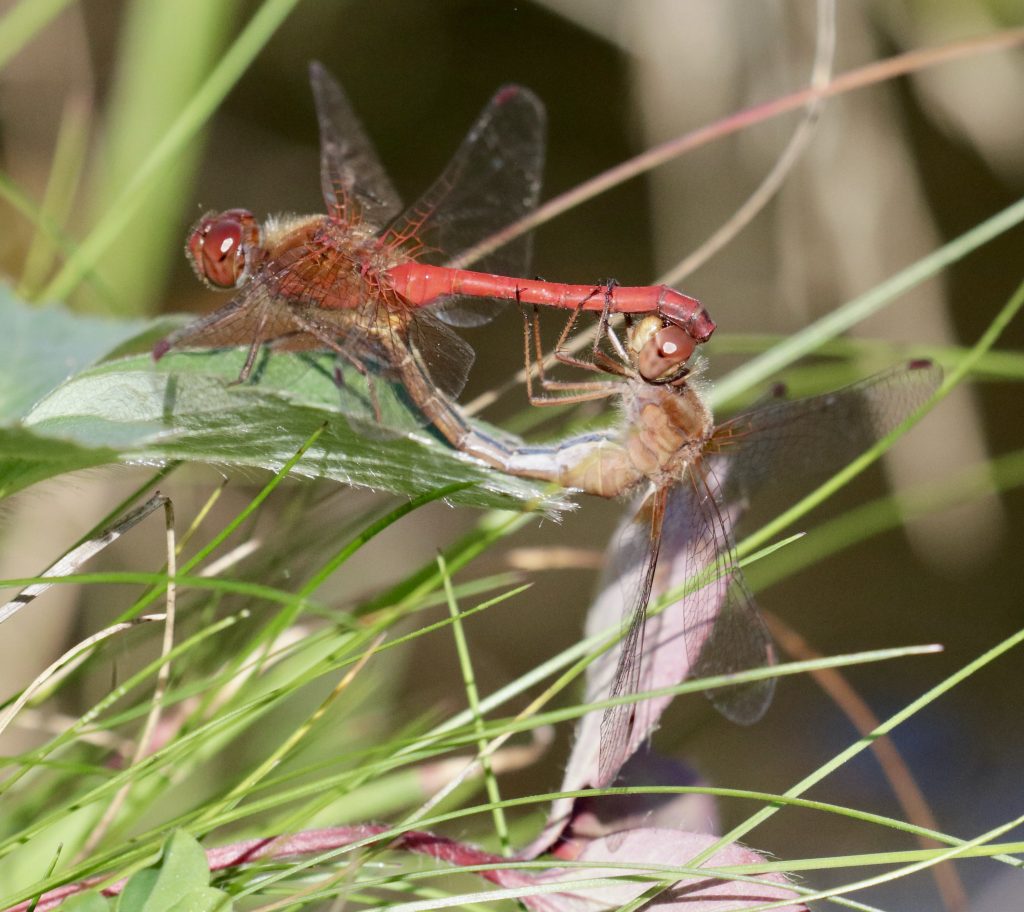
The sex life of dragonflies is rather unusual. The males store sperm up near their thorax, transferring this from the end of their abdomens by curling these under and forward along their bodies. When females link up, the two bodies loop together in the wheel position that allows for the transfer of sperm to the female for the fertilization of her eggs.
In some species males can remove sperm previously deposited by a rival male, or reposition it so there is less likelihood of fertilising the female’s eggs — the process relies on anatomical adaptions of the males reproductive system. How long pairs remain in tandem is dependent upon which strategy is operating; in some species the couple remain linked when egg laying commences, preventing other males from engaging with the female ensuring the accompanying males’ genetic line, although in some cases the female will break free to lay eggs independently and is them subjected to the attentions of other suitors. How long and whether females remains linked to a male depends on both circumstances and species. There is a lot more to be understood about the processes, particularly in relation to natural selection — with the Odonata providing the best examples so far observed of anatomical traits that relate to sperm competition.

By any standards dragonflies have been successful for millions of years and this isn’t over. Impressively, Britain has gained eight new dragonfly species since 1985 — in a country where many other plants and animals are rapidly disappearing. It is too early to say if this move northwards due to global climate change is permanent, and there could be other problems on the horizon if weather patterns continue to become more extreme.

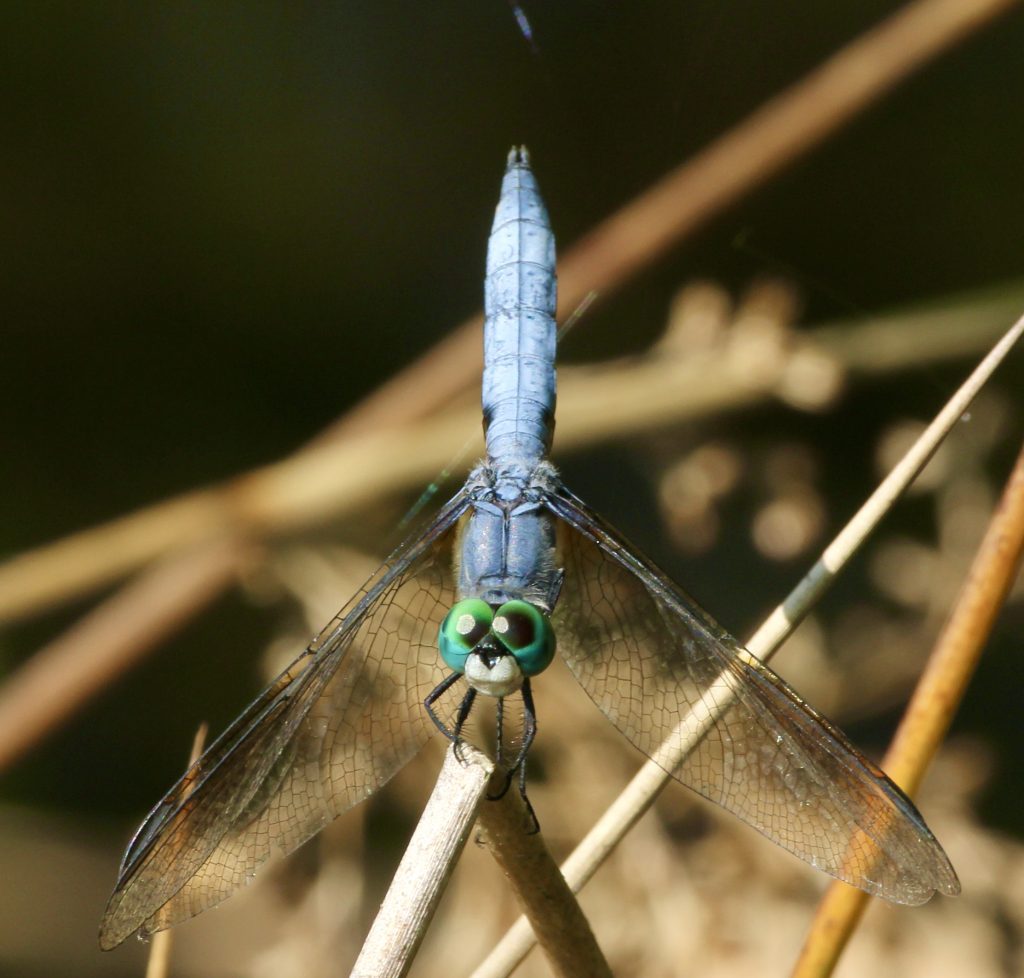
The order of dragonflies has already survived several mass extinction events including the one that took out the dinosaurs; and if I was a gambler I’d bet they’d probably survive the next one, but there is a no denying the possibility that our species may not… Whether I might win such a bet would depend on the urgent need for us to deal with both climate change and the continuing reduction of species diversity, because if nothing changes, making a killing will inevitably take on a broader and more devastating meaning.




This is such an interesting and informative article about dragonflies. I found it while trying to research the insects for a video I want to create. I’ve recently filmed some blue dashers in my backyard, and I realized that I didn’t know much about dragonflies. I just knew their basic life cycle. I was curious about their evolution, and your article gave me some insights I hadn’t known before. Thanks for sharing this!
Thank you Macey. I hope the video goes well.